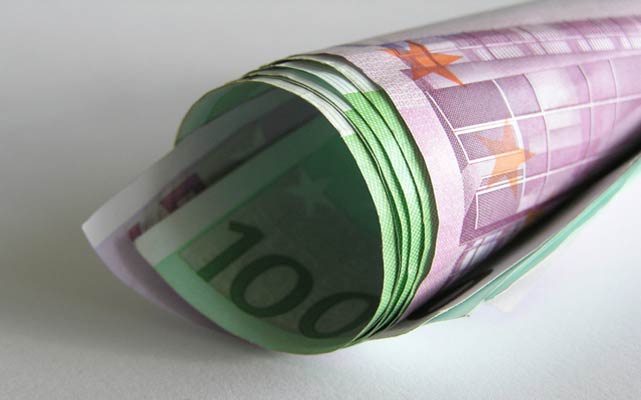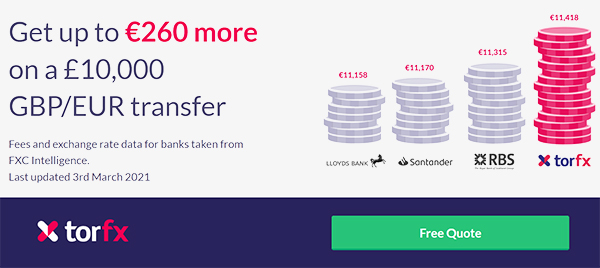Euro to Dollar Forecast RAISED to 1.14 in 12 Months at Danske Bank
April 10, 2025 - Written by David Woodsmith

Since the US tariff policy was unveiled, the Euro (EUR) has been subjected to very choppy trading against the US Dollar (USD).
EURUSD is currently trading at 6-month highs just below 1.12 handle, quoted at 1.11936 (+2.22%).
A move above 1.1280 would be a 3-year high.
Several Investment Banks Slash Dollar Forecasts, New EUR/USD Targets Published
Many investment banks have maintained a bullish stance on the US dollar over the past few months based, to an important extent, on US exceptionalism.
There was talk of EUR/USD sliding to parity, but several key banks have now shifted their view and further forecast revisions are inevitable in the short term.
Nordea, for example, commented; “We have made a complete reversal in our dollar outlook and now expect the dollar to weaken rather than strengthen.”

Goldman Sachs has shifted its view sharply; “We have made a major shift in our Dollar view after seeing the developments of the last few weeks and rethinking the likely implications of these policy changes. We now expect recent Dollar weakness to persist, particularly in DXY terms.”
Goldman has increased its 12-month EUR/USD forecast to 1.20 from 1.02 previously.
Nordea has abandoned its call for a EUR/USD slide to 1.04 and has raised its end-2025 forecast to 1.12 from 1.07.
There has been persistent optimism that the US economy would out-perform Europe with this strength also encouraging further capital flows into US asset markets and maintaining strong dollar demand.
Expectations of Trump Administration tax cuts underpinned US growth hopes while there were also expectations that US trade tariffs would tend to underpin the dollar on defensive grounds.
The dollar index (DXY) hit 2-year highs in early January on a wave of Trump trades, but has since slumped close to 8% to 6-month lows.
Reaction to the aggressive trade policy has been a key element with the dollar weakening rather than strengthening amid the slide on Wall Street.

Scotiabank noted; “An unusual aspect of the recent market volatility is that the USD has fallen in tandem with the sharp decline in US equities. The lack of haven bid for the USD amid the sharp rise in broader market uncertainty and volatility raises a valid question about whether the USD is losing its “traditional” safe-haven status.”
The bond market has also been under sustained pressure.
HSBC delved into the statistics.
It noted; “It is rare to see US 10-year Treasury yields go up, the S&P 500 decline, and the USD struggle.
According to the bank, this has happened less than 7% of times.
HSBC commented that; “it could amplify concerns how a regime shift is unfolding and a bigger USD test is coming via its structural vulnerabilities.”
The bank is less confident in its bullish dollar view; “We have pushed back against such concerns over the years given resilient US growth supporting high yields and solid foreign demand for US assets. Yet, we cannot easily brush aside the USD’s structural weaknesses, especially given the current climate.”
Goldman cited three reasons for changing its view; “the combination of an unnecessary trade war and other uncertainty-raising policies is severely eroding consumer and business confidence. Second, negative trends in US governance and institutions are eroding the appeal of US assets for foreign investors. Third, rudimentary calculations and a constant back-and-forth makes it difficult for investors to price outcomes other than high uncertainty.
Danske Bank expects a notable negative economic impact; “Trump's tariff proposals are set to significantly increase the weighted average tariff on US imports to levels not seen since the 1920s. Taken together, the tariff measures proposed this year would amount to the largest tax hike on the US consumer since World War II. In our view, this materially increases the risk of a US recession in 2025.”
Danske Bank has raised its 12-month EUR/USD forecast to 1.14 from 1.06.
Scotiabank sees an erosion of defensive support; “The USD’s safe haven status is being eroded as market participants grapple with the aggressive shift in US trade strategy, the implications for its trading partners, and the alternative opportunities available to traditional holders of US Treasuries as a result of changing fiscal attitudes in Europe.”
Nordea focussed on a shift in fiscal policy with attempts to curb US Federal spending. It commented; “The opposite is happening in rest of the world. Europe is focused on increasing military expenditures and public spending.”
Germany has launched a EUR500bn infrastructure plan and a new coalition has been agreed.
Nordea added; “The shifting fiscal policy and economic outlook is in favor of the euro versus the dollar, which is being reinforced by capital flows in the same direction. The rest of the world is overallocated in the US compared to historical average and a normalization will lead to further net dollar sales.”
ING noted an important element of uncertainty; “second-guessing the President’s next move has been a painful process to many, and ultimately we think he will get his way with a broadly weaker dollar, albeit a story for later this year and into 2026.”
The bank will adjust its forecasts shortly and is likely to downgrade dollar forecasts.
According to SocGen; “The global economy’s best hope is that this trade war is short. The alternative outcome is weaker growth for everybody, and a sharp slowdown in capital flows to the US, which would trigger a significant fall for the dollar.”
UBS has a March 2026 EUR/USD forecast of 1.14.
STORY LINK Euro to Dollar Forecast RAISED to 1.14 in 12 Months at Danske Bank

Since the US tariff policy was unveiled, the Euro (EUR) has been subjected to very choppy trading against the US Dollar (USD).
EURUSD is currently trading at 6-month highs just below 1.12 handle, quoted at 1.11936 (+2.22%).
A move above 1.1280 would be a 3-year high.
Several Investment Banks Slash Dollar Forecasts, New EUR/USD Targets Published
Many investment banks have maintained a bullish stance on the US dollar over the past few months based, to an important extent, on US exceptionalism.
There was talk of EUR/USD sliding to parity, but several key banks have now shifted their view and further forecast revisions are inevitable in the short term.
Nordea, for example, commented; “We have made a complete reversal in our dollar outlook and now expect the dollar to weaken rather than strengthen.”

Goldman Sachs has shifted its view sharply; “We have made a major shift in our Dollar view after seeing the developments of the last few weeks and rethinking the likely implications of these policy changes. We now expect recent Dollar weakness to persist, particularly in DXY terms.”
Goldman has increased its 12-month EUR/USD forecast to 1.20 from 1.02 previously.
Nordea has abandoned its call for a EUR/USD slide to 1.04 and has raised its end-2025 forecast to 1.12 from 1.07.
There has been persistent optimism that the US economy would out-perform Europe with this strength also encouraging further capital flows into US asset markets and maintaining strong dollar demand.
Expectations of Trump Administration tax cuts underpinned US growth hopes while there were also expectations that US trade tariffs would tend to underpin the dollar on defensive grounds.
The dollar index (DXY) hit 2-year highs in early January on a wave of Trump trades, but has since slumped close to 8% to 6-month lows.
Reaction to the aggressive trade policy has been a key element with the dollar weakening rather than strengthening amid the slide on Wall Street.

Scotiabank noted; “An unusual aspect of the recent market volatility is that the USD has fallen in tandem with the sharp decline in US equities. The lack of haven bid for the USD amid the sharp rise in broader market uncertainty and volatility raises a valid question about whether the USD is losing its “traditional” safe-haven status.”
The bond market has also been under sustained pressure.
HSBC delved into the statistics.
It noted; “It is rare to see US 10-year Treasury yields go up, the S&P 500 decline, and the USD struggle.
According to the bank, this has happened less than 7% of times.
HSBC commented that; “it could amplify concerns how a regime shift is unfolding and a bigger USD test is coming via its structural vulnerabilities.”
The bank is less confident in its bullish dollar view; “We have pushed back against such concerns over the years given resilient US growth supporting high yields and solid foreign demand for US assets. Yet, we cannot easily brush aside the USD’s structural weaknesses, especially given the current climate.”
Goldman cited three reasons for changing its view; “the combination of an unnecessary trade war and other uncertainty-raising policies is severely eroding consumer and business confidence. Second, negative trends in US governance and institutions are eroding the appeal of US assets for foreign investors. Third, rudimentary calculations and a constant back-and-forth makes it difficult for investors to price outcomes other than high uncertainty.
Danske Bank expects a notable negative economic impact; “Trump's tariff proposals are set to significantly increase the weighted average tariff on US imports to levels not seen since the 1920s. Taken together, the tariff measures proposed this year would amount to the largest tax hike on the US consumer since World War II. In our view, this materially increases the risk of a US recession in 2025.”
Danske Bank has raised its 12-month EUR/USD forecast to 1.14 from 1.06.
Scotiabank sees an erosion of defensive support; “The USD’s safe haven status is being eroded as market participants grapple with the aggressive shift in US trade strategy, the implications for its trading partners, and the alternative opportunities available to traditional holders of US Treasuries as a result of changing fiscal attitudes in Europe.”
Nordea focussed on a shift in fiscal policy with attempts to curb US Federal spending. It commented; “The opposite is happening in rest of the world. Europe is focused on increasing military expenditures and public spending.”
Germany has launched a EUR500bn infrastructure plan and a new coalition has been agreed.
Nordea added; “The shifting fiscal policy and economic outlook is in favor of the euro versus the dollar, which is being reinforced by capital flows in the same direction. The rest of the world is overallocated in the US compared to historical average and a normalization will lead to further net dollar sales.”
ING noted an important element of uncertainty; “second-guessing the President’s next move has been a painful process to many, and ultimately we think he will get his way with a broadly weaker dollar, albeit a story for later this year and into 2026.”
The bank will adjust its forecasts shortly and is likely to downgrade dollar forecasts.
According to SocGen; “The global economy’s best hope is that this trade war is short. The alternative outcome is weaker growth for everybody, and a sharp slowdown in capital flows to the US, which would trigger a significant fall for the dollar.”
UBS has a March 2026 EUR/USD forecast of 1.14.
International Money Transfer? Ask our resident FX expert a money transfer question or try John's new, free, no-obligation personal service! ,where he helps every step of the way, ensuring you get the best exchange rates on your currency requirements.
Comments are currrently disabled
Related Stories:
- Pound to Euro Forecast: Buy Dips to 1.1430, March 2026 Target 1.1765 say UBS - April 11, 2025
- Euro to Dollar Forecast RAISED to 1.14 in 12 Months at Danske Bank - April 10, 2025
- Pound to Dollar Forecast: Sterling Buyers Takes Advantage of Risk Recovery - April 10, 2025
- Euro to Pound Forecasts RAISED to 0.86 in Six Months at Rabobank - April 9, 2025
- Pound Sterling Forecast: GBP Recovers vs EUR USD, Next US-China Moves Crucial - April 8, 2025
- Pound Sterling to Euro Forecast Slashed to 1.1765 in 3 Months at Goldman Sachs - April 8, 2025
- Pound to Euro Week Ahead Forecast: Further Losses to 1.1695 After Sterling Slide - April 7, 2025
- Pound to Dollar Forecast: Best Buying Below 1.30, 2025 Target Still 1.36 - April 6, 2025
- Pound, Euro and Dollar Forecast: What Analysts Expect on Liberation Day! - April 2, 2025
Latest News:
- Pound-to-Euro Rate Recovers as Dollar Battered on Bond Sell-off - April 12, 2025
- Euro to Dollar Forecast: Three-Year Best, EUR/USD at 1.20 Possible - April 12, 2025
- Pound to Euro Forecast: Buy Dips to 1.1430, March 2026 Target 1.1765 say UBS - April 11, 2025
- "Sell America": US Dollar Collapse Boosts Safe Havens Yen, Franc and Euro - April 11, 2025
- UK Economy: Pound Sterling Tests 1.30, GDP Boost Eclipsed by US Dollar Slide - April 11, 2025
- Euro to Dollar Forecast RAISED to 1.14 in 12 Months at Danske Bank - April 10, 2025
- Pound to Dollar LIVE: Soft Inflation Print Sends Sterling Past 1.29 - April 10, 2025
- GBP/USD Prediction: Pound Sterling Outlook Flips "Neutral-Bullish" say Scotiabank - April 10, 2025
- Pound to Euro Rate Dragged Lower by EUR/USD Rally to 1.11 - April 10, 2025
- EUR/GBP Outlook: Pound Dips vs Euro on Drop in UK gilts, Rise in Yields - April 10, 2025








